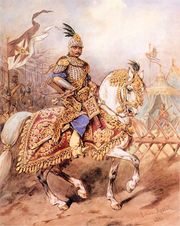Rotmistrz: Różnice pomiędzy wersjami
(Utworzył nową stronę „'''Rotmistrzowie w rodzie Ostoi''' *”) |
|||
| (Nie pokazano 10 pośrednich wersji utworzonych przez tego samego użytkownika) | |||
| Linia 1: | Linia 1: | ||
| − | + | [[Plik:Rotmistrz.jpg|180px|right]] | |
| + | [[Plik:English flag.png|link=Ostoja - Main page|20px]] [[Plik:Button-flaga-polski.jpg|link=Ostoja - strona główna|30px]] | ||
| − | + | '''Rittmeister''' - in the Polish army (from the 15th century to the mid-20th century) a Rotmistrz commanded a formation called a rota. The Lithuanian name was rotmistras. In earlier times the rotmistrz served as the commander of an infantry or cavalry company, though sometimes he would temporarily be assigned field-grade tasks commanding an entire regiment or even a larger formation. In the cavalry the rank continued until 1945 as a company-grade title. Applied to the commander of a troop, it was equivalent to a modern-day Captain, although a Rotmistrz in Poland and Lithuanian was traditionally one of the most wanted assignments as it was also a honorary title and honor to lead a company that was formed only by men of noble origin. | |
| + | : | ||
| + | : | ||
| + | |||
| + | '''Rotmistrz''' - W Polsce nazwa rotmistrza pojawiła się w XV wieku, gdy po raz pierwszy w polskich dziejach użyte zostało wojsko zaciężne. Rotmistrz zaciągał na podstawie listu przypowiedniego rotę konną lub pieszą, nad którą obejmował dowództwo. W XVI wieku nazwę rotmistrza piechoty zaczęła wypierać nazwa kapitan. Rotmistrz był bardzo honorowym stopniem, wielce popularnym, dowodzil jazdą konną złożoną oficerów pochodzenia szlacheckiego i dlatego przewodzenie rotą było dla wielu sprawą honoru. | ||
| + | |||
| + | '''Rotmistrzowie w rodzie Ostoi, w kategorii niżej - Rittmeisters in Ostoja, see category below.''' | ||
| + | [[Kategoria:Rotmistrz]] | ||
Aktualna wersja na dzień 21:33, 23 lip 2016
Rittmeister - in the Polish army (from the 15th century to the mid-20th century) a Rotmistrz commanded a formation called a rota. The Lithuanian name was rotmistras. In earlier times the rotmistrz served as the commander of an infantry or cavalry company, though sometimes he would temporarily be assigned field-grade tasks commanding an entire regiment or even a larger formation. In the cavalry the rank continued until 1945 as a company-grade title. Applied to the commander of a troop, it was equivalent to a modern-day Captain, although a Rotmistrz in Poland and Lithuanian was traditionally one of the most wanted assignments as it was also a honorary title and honor to lead a company that was formed only by men of noble origin.
Rotmistrz - W Polsce nazwa rotmistrza pojawiła się w XV wieku, gdy po raz pierwszy w polskich dziejach użyte zostało wojsko zaciężne. Rotmistrz zaciągał na podstawie listu przypowiedniego rotę konną lub pieszą, nad którą obejmował dowództwo. W XVI wieku nazwę rotmistrza piechoty zaczęła wypierać nazwa kapitan. Rotmistrz był bardzo honorowym stopniem, wielce popularnym, dowodzil jazdą konną złożoną oficerów pochodzenia szlacheckiego i dlatego przewodzenie rotą było dla wielu sprawą honoru.
Rotmistrzowie w rodzie Ostoi, w kategorii niżej - Rittmeisters in Ostoja, see category below.
